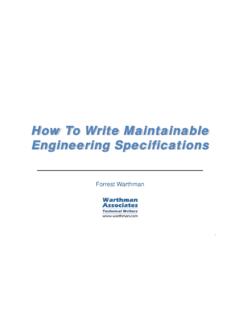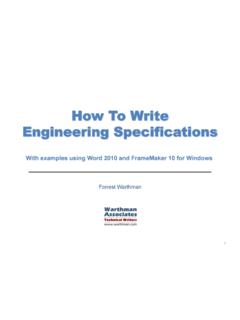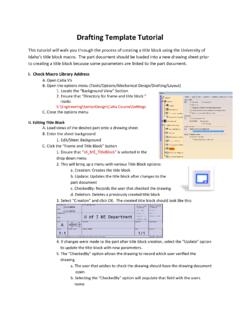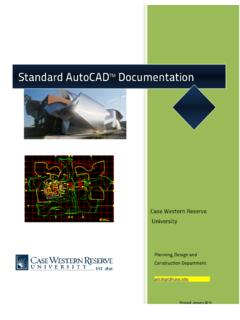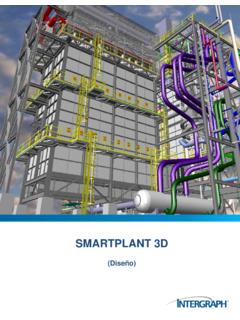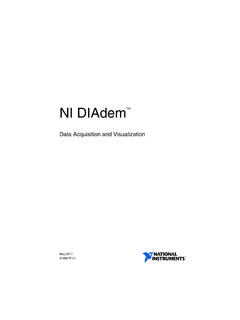Transcription of How To Write Engineering Specifications - Warthman
1 How To Write Engineering Specifications With examples using Word 2010 and FrameMaker 10 for Windows 1 Forrest Warthman Outline Part 1: Content Motivations and audience Scheduling Assembling content Creating figures and tables Writing Language, words, names, and references Part 2: Implementation Editing tools Formats and templates Figures and tables Footnotes Cross-references Comparing documents 2 Part 1: Content Motivations and audience Scheduling Assembling content Creating figures and tables Writing Language, words, names, and references 3 Motivations Engineering Specifications serve several functions: Specify how a design shall be implemented.
2 Clarify agreements on design goals and methods. Tutorial for new members of an Engineering team. Starting point for other documents (patent applications, presentations, technical manuals, user guides, training scripts ..). For each function: Audience may have different needs and expectations. Content may need to be modified or expanded. Ease of modification depends on how well the original specification is written and formatted. 4 Identify the Audience Audiences have different knowledge than you: They may not know details of your ideas or product. They may not know all of your names and acronyms.
3 They may have different questions than you have. They may not understand the English language well. Before you start, ask: What are the skills and interests of your audience? What do they need to know? Imagine yourself as the audience, and speak to them. Start by writing an unordered list of topics: Then order the list for flow, from general to specific. 5 Estimate a Schedule Start with an approximate schedule: Plan and assemble source material: 5% of total time. Those you understand best and can articulate most quickly. Draft #1 and Review: 85% of total time.
4 Make the first draft look like the finished document. Draft #2 and Review: 5% of total time. Identify and fix all errors and omissions. Final (no review): 5% of total time. 6 Assemble Content Find in-house sources: Your own knowledge or hands-on use. Hands-on use, or interviews with colleagues. Engineering Specifications , presentations, patents. Find external sources: Industry journals, technical textbooks, competitors publications. Search your bookshelf, the Internet, or a library. Assess the quality of sources: Is their content similar or relevant to your topic?
5 What content is missing from the sources? 7 Create Figures and Tables Create figures that summarize your text: Begin each section with an overview figure. Create figures in two different ways: Translate a summary of your text into a figure. Create a figure, and then Write text to explain the figure. Start by hand-sketching rough figures. Later, implement the sketches in a drawing application. Create tables that augment or summarize your text: Create matrices that define and compare parameters. Use tables as cross-references and indexes that help readers random-access content quickly.
6 8 Start Writing Create a list of topics (the Outline ): Start with an unordered list, writing down any topics that come to your mind, in any order. Then, order the list for flow, from general to specific. Fill in the content: Write the easiest sections first: Those you understand best and can articulate most quickly. Begin each section with an overview. Summarize context, function, purpose, control, resources. Build the document, following your list of topics. Define acronyms and special terms up front. Don t get writer s block just start writing.
7 9 Language Use clear, simple language: Every sentence needs a subject (noun phrase) and a predicate (verb phrase). Wrong: The Stop bit is set at boot time . The predicate ( is set ) is incomplete. It does not say what performs the action, , software or hardware. Right: Software must set the Stop bit at boot time . Write sentences that can be read fast. Shorter sentences, simpler words. For most readers, English is a second language. They appreciate simplicity and clarity. 10 Words Avoid ambiguous words and symbols: What does MSB mean? Most-significant byte , or most-significant bit ?
8 Does it specify not only memory ordering but also what comes first-in-time on a serial link or a parallel bus? Does slash (/) mean AND, OR, or AND-or-OR? Some engineers are not clear about their use of this symbol. Do not use undefined abbreviations or acronyms. If you use them, define them on first use and provide a glossary at the beginning of the document. 11 Names Use names consistently: Here is an example: "An AND gate can be built from a NAND, and a NAND would require two less gates than an AND." So, what does gate mean? Is it the AND or NAND, or is it a subcomponent from which the AND and NAND are made?
9 Always use the same name for the same thing: Pick one name for each thing: , function or block . Use only that name; do not use aliases (synonyms). Undeclared aliases in computer programs result in errors. Human brains work like computer programs in this respect. This is a BIG problem in Engineering Specifications . 12 Compounds Compound Nouns and Noun-Modifiers: What does ten tapped filters mean? "ten filters with taps ? "filters with ten taps ? Add a hyphen to clarify the meaning: ten-tapped filters (hyphenate the compound noun-modifier). ten tapped-filters (hyphenate the compound noun).
10 13 References Use clear references: What are this and that referring to? Example: The disk drive makes a loud rattle when a programmatic branch causes the head to seek a distant track; this should be avoided. So, what this should we avoid? Writing programs that have branches? Storing branch targets in distant disk tracks? A loud rattle, no matter how it is caused? 14 Part 2: Implementation Editing tools Formats and templates Figures and tables Footnotes Cross-references Comparing documents 15 Popular Editing Tools Writing tools: Microsoft Word (Windows or Mac): Pros: price, widely used.
